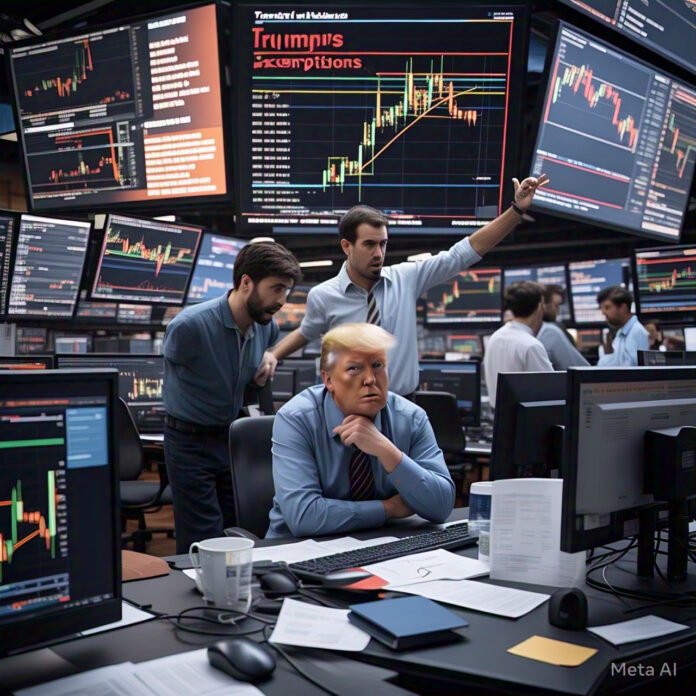Breaking Down the Market Meltdown
Global markets are in turmoil today as conflicting reports emerge about which industries will receive exemptions from President Trump’s sweeping 125% tariffs on Chinese goods. The S&P 500 dropped 2.8%, while the Nasdaq plunged 3.5% as investors scrambled to interpret the administration’s mixed signals.
Key Developments Driving Volatility:
- Selective Exemptions: Reports suggest some tech and pharmaceutical imports may avoid tariffs, but no official list exists
- China’s Immediate Response: Beijing announced surprise tariffs on U.S. agricultural exports and restrictions on rare earth mineral shipments
- Corporate Whiplash: Major companies like Apple and Tesla saw 5%+ single-day drops as their supply chain status remains unclear
The Exemption Puzzle: Who’s In, Who’s Out?
Industries in Limbo
| Sector | Likely Status | Potential Impact |
|---|---|---|
| Semiconductors | Partial exemptions | Chip shortages could ease but prices may still rise 15-20% |
| Pharmaceuticals | Mostly exempt | Minimal disruption to drug supplies |
| Consumer Electronics | No exemptions | iPhone prices could jump $200+ |
| Auto Parts | Case-by-case | Production delays likely for U.S. automakers |
“This isn’t a policy – it’s chaos,” remarked Goldman Sachs chief economist Jan Hatzius. “Markets hate uncertainty more than they hate bad news.”
China’s Calculated Counterstrike
Beijing has launched what analysts call “asymmetric retaliation” – carefully targeted measures designed to maximize U.S. political pain while minimizing economic self-harm:
- Agricultural Hitlist:
- 50% tariff on U.S. soybeans (directly targeting Iowa farmers)
- Ban on pork imports (impacting North Carolina producers)
- Tech Blockade:
- Delayed approvals for Qualcomm-MaxLinear deal
- New export controls on specialized manufacturing equipment
- Financial Warfare:
- State-owned banks quietly reducing dollar holdings
- Accelerating yuan-based oil trade with Russia and Saudi Arabia
Market Reactions: Where the Money Is Moving
Biggest Losers
- Tech (XLK): -4.2% (Apple, NVIDIA hardest hit)
- Consumer Discretionary (XLY): -3.8% (Tesla, Home Depot plunging)
- China ETFs (MCHI): -6.1% (Worst day since 2022)
Surprising Gainers
- Defense Stocks (LMT, RTX): +3.5% on geopolitical tensions
- Domestic Manufacturers (XLI): +1.2% on reshoring hopes
- Commodities (DBC): +2.8% as trade routes reconfigure
What Comes Next: Three Critical Scenarios
- Clarity Scenario (20% Probability)
- White House releases official exemption list within 48 hours
- Markets recover half of losses by week’s end
- Escalation Scenario (55% Probability)
- China restricts lithium exports (crushing U.S. EV ambitions)
- Trump responds with secondary sanctions
- S&P tests 4,800 support level
- Freeze Scenario (25% Probability)
- Both sides agree to emergency trade talks
- Temporary tariff pause announced
- Tech stocks lead relief rally
Smart Money Moves Right Now
- Immediate Plays:
- Buy volatility hedges (VXX, UVXY)
- Rotate into healthcare and utilities
- Short yuan via CYB ETF
- Long-Term Positioning:
- Accumulate quality industrials at discounts
- Build cash reserves for coming opportunities
- Research ASEAN manufacturing alternatives
The Bottom Line
This isn’t 2018’s trade war – it’s Trade War 2.0 with higher stakes and less predictability. While exemptions may provide temporary relief, structural decoupling appears increasingly inevitable. Investors should prepare for sustained volatility as the world’s two largest economies rewrite the rules of global commerce.
“We’re not just talking about tariffs anymore,” warns former USTR official Stephen Vaughn. “This is the beginning of a fundamental reorganization of global supply chains that will take a decade to play out.”
Key Questions Remaining:
- Will Europe get dragged into the conflict?
- Can U.S. manufacturers actually fill the production gap?
- How will the Fed respond to potential inflation spikes?


